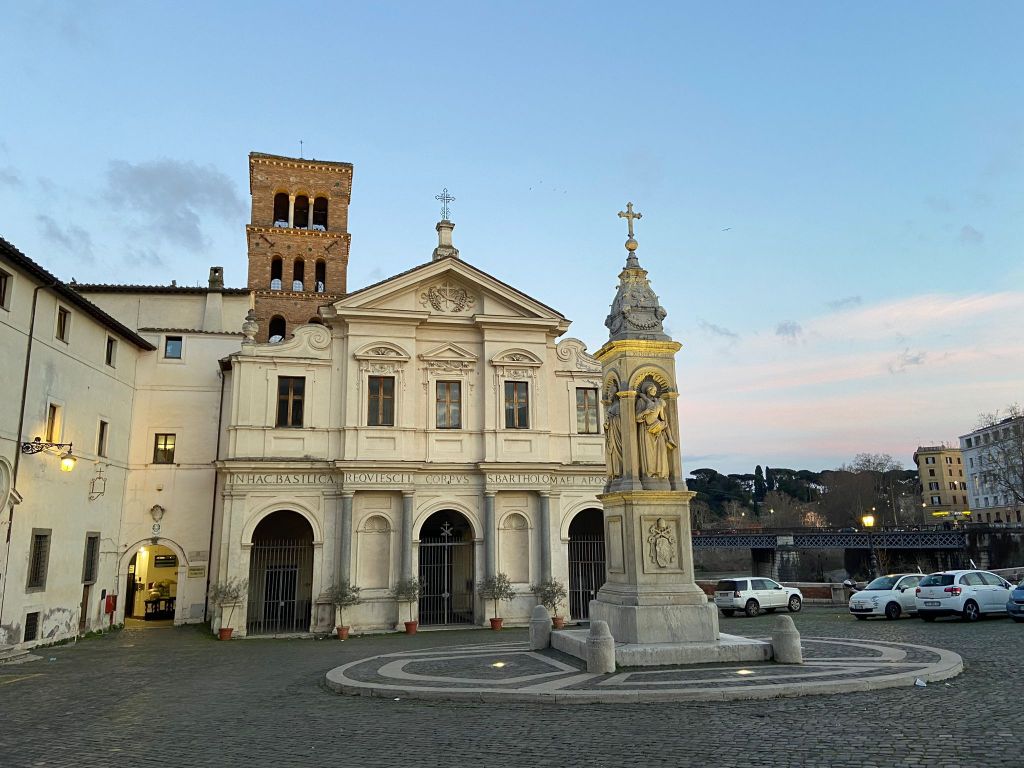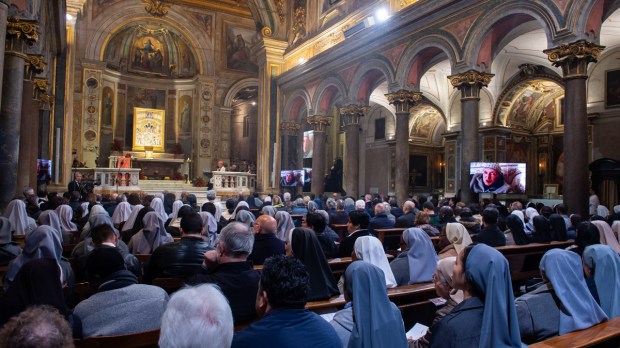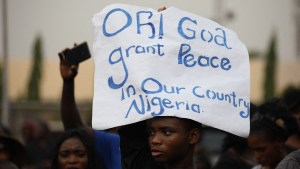Nestled between the rapid currents of the Tiber and below the centenary trees that line its banks is l’Isola Tiberina (the Tiber Island). This small piece of land, surrounded by the Jewish neighborhood on one side and the Trastevere neighborhood on the other, hosts the Basilica of San Bartolomeo all’Isola (Saint Bartholomew on the Island). This church has a unique feature besides its geography, as it preserves the memory and relics of martyrs of the 20th and 21st century.
In preparation for the Great Jubilee of 2000, Pope John Paul II established a Commission of New Martyrs, to investigate Christian martyrdom in the 20th century. To highlight this body’s work, the Pontiff decided to dedicate the Basilica of San Bartolomeo to these new witnesses of faith.
In fact the church, which is run by the Community of Sant’Egidio, is divided into chapels which feature the modern martyrs from specific regions or time periods.
On occasion of the European Day of the Righteous, Aleteia tells some of the stories held in the chapel dedicated to those persecuted by Nazism. This remembrance day celebrates those that have fought for human dignity in light of genocides, crimes against humanity, or totalitarianism throughout the world. It is held on the 6th of March, the date of death of Moshe Bejski, a Polish-born Israeli Supreme Court Justice and Holocaust survivor who helped honor many of those who helped rescue Jews during the Second World War.

Saint Maximilian Kolbe’s relics
Saint Maximilian Kolbe was a Polish Franciscan priest who sacrificed his life in 1941 in order to save a husband and father who had been sentenced to death in the Auschwitz concentration camp. The chapel holds the Saint’s relics and prayer book. To read more about him click here.
Blessed Maria Restituta: beheaded for hanging crucifixes
In the chapel there is a cross belonging to Sister Maria Restituta, who defied the Nazis by hanging crucifixes in the hospital she worked for. She was eventually arrested and then beheaded in 1943. To read more about her story, click here.
A beatified Ukrainian-Greek Catholic priest who tried to save Jews by giving baptism certificates
An icon of Father Emilian Kovch hangs in the Chapel to remember this Ukranian-Greek Catholic priest, and father of six, who died in a concentration camp after trying to save hundreds of Jews. To read more about his story, click here.
“I am not ashamed of the Gospel […] it is the power of God for the salvation of everyone who believes”
The church also includes the stories of individuals belonging to other Christian religions. An example is a letter written by Evangelical pastor, Paul Schneider, to his family members while he was in the Buchenwald concentration camp in Germany. He then died there in 1939, leaving behind his wife and six children. However, there is evidence of Pastor Schneider’s unwillingness to bend to the Nazi regime as early as 1933.
“Last Sunday I preached again on Romans 1:16. For I am not ashamed of the Gospel; for it is the power of God for the salvation of everyone who believes; of the Jew first and then of the Greek. I do not believe that our Evangelical Church will be able to avoid a confrontation with the Nazi state, nor even that it will be able to postpone it much longer,” he wrote in October 1933, after an initial complaint about his preaching. Pastor Schneider continued strongly denouncing the Nazi ideology and publicly defending the Jews. He was finally arrested and then deported to Buchenwald in 1937.
A letter from an important Polish Lutheran bishop
Another example is a letter from Polish Lutheran bishop, Juliusz Bursche, which he sent to his family members from the Sachsenhausen concentration camp in Germany. Between the two world wars Bishop Bursche helped establish the Evangelical Church of the Augsburg Confession, a Lutheran denomination, in Poland. It was legally recognized in 1937 and he was nominated its first bishop. However, with the outbreak of the Second World War divisions due to nationalistic ideologies took over the Church.
“The task of the Church is to proclaim the Gospel, not to proclaim German or Polish national ideology,” Bishop Bursche said. He was arrested by the German authorities in 1939 and then died in 1942. It is estimated around 30% of Poland’s Evangelical clergy died in concentration camps during the Second World War.
The German politician who believed the Church “must have the right to take action”
Eugen Bolz was a Catholic German politician who fervently opposed the Nazi ideology. In fact as early as 1933 he was placed in a concentration camp for several weeks due to his positions. “The Church must have the right to take action against those laws that endanger the vital interests of the Churches and the good of believers. If a law contradicts natural laws or divine law, it cannot, according to Catholics, bind the conscience,” he wrote.
After being freed he decided to leave politics for some time, before coming into contact with a Nazi resistance group led by Carl Goerdeler. Bolz was eventually arrested in 1944 and sentenced to death. The church on the Tiber Island features the pyx with which Bolz’s wife and daughter secretly brought him Communion in prison, after his jailers had forbidden him from receiving the Eucharist.
One of 108 Polish martyrs
In the chapel there is a letter written by Stanislaw Starowieysky, a Polish layman who was beatified as part of a group of 108 Polish martyrs of the Second World War. Before the war he was an active Church member and helped organize a Diocesan Eucharistic Congress in Chelm and supported the Catholic Action. During the Second World War he housed many fugitives and refugees in his home until he was arrested in 1939. After an initial escape he was then arrested again by German troops in 1940 and was ultimately taken to the Dachau concentration camp. A father of six, he died 13 April 1941, on the night between Holy Saturday and Easter Sunday
The witness of a young Italian Dehonian Father
Dehonian Father, Martino Nicola Capelli, was killed by Nazi troops in Italy at only 32 years old. He was serving as a priest in a small town in the north of the country when the SS forces decided to kill hundreds of people in the Marzabotto area, in retaliation for the deaths of German soldiers. As Father Capelli was assisting the wounded with another priest, they were captured and forced to carry the soldiers’ weapons and munitions. They were then murdered along with other civilians on October 1, 1944. A letter written by Father Capelli is featured in the chapel.
A letter by a Catholic layman
The Ccapel also features a letter by Heinrich Ruster, a Catholic layman who worked in the media and frequently published material against Adolf Hitler and the Nazis. He was killed on October 23, 1942, at the Sachsenhausen concentration camp in Germany.
“To you my beloved and faithful companion I give all the strength of my heart; it beats every hour for you, that you may know it. And in this imperturbable communion we carry our destiny with righteousness and trust in God!” Ruster wrote in a letter addressed to his wife, now preserved in this chapel in Rome.


